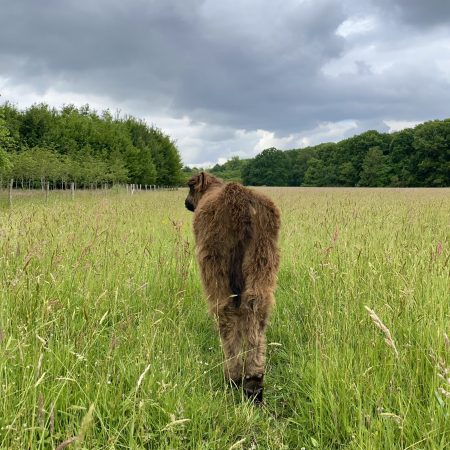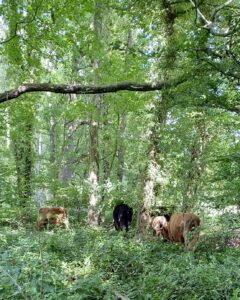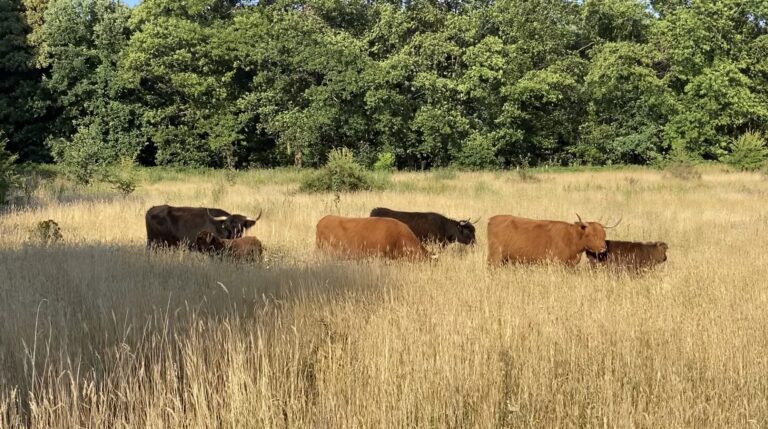Step into our office
Where the gardening gets done
Our Highlanders are put to work on different locations. On the one hand we have the seasonal workers grazing private property. On the other hand we have long-term employed animals working in nature reserves.
Conservation grazing as nature management is up and coming. Considering the advantages, it looks like an obvious choise to make. Not only Highlanders are known for their excellent work: sheep, Konik horses, ponies and other cattle are most known for their grazing skills.
For centuries grazing has been associated with stock breeding, since it was a part of agricultural production. In agricultural grazing the use of land will be optimized with fertilization as a common tool.
This kind of intensive grazing as a part of intensive stock breeding usually leads to manure surplus that can be damaging for the environment. Intensive grazing maintains an area as a habitat dominated by grasses and small shrubs, largely preventing ecological succession to forest and disturbing or even destroying ecological processes.
However, grazing can be organized in an ecological way. The essence of natural grazing is that livestock can graze all year round without interference or restrictions. They are for example free to roam the nature reserve and migrate to other areas and reproduction or mortality in the herd isn’t controlled by man. This does not mean that we leave our cattle high and dry. We keep monitoring our Coos. They will get their yearly vaccinations against IBR and Blue Tongue and their general health will be supervised.

Teach ’em young: Bugs planning work in Liedekerkebos
Conservation grazing with specifically selected grazing species as nature management is relatively new in our regions. In Belgium, nature management through large grazers only started after 1975.
Conservation grazing aims to replicate the effect of large herbivores which roamed the land in earlier times. Natural grazing can have different goals: to (re)create more wilderness, to restore natural processes, to maintain or to increase biodiversity.
Our Highlanders are excellent landscapers and their job will be to maintain and increase biodiversity and they are tailor-made for the job: they will trample areas of bracken, allowing flowers to flourish, their dung provides excellent fertilizer for the ground and by becoming attached to their coat, wildflower seeds are spread all over.

Our fold hard at work
On private property, our Heilan Coos work behind closed doors, but you can of course always pay them a visit in their public work domain.
Some of our ladies, and with some luck sometimes a gentleman too, are showcasing their skills in the woods of Hertigembos/Liedekerkebos on the border of Sint-Katherina-Lombeek and Liedekerke, in the Pajottenland, in the Nature of Ter Pede (Schepdaal) and Sint-Martens-Bodegem (both Dilbeek) and on the hills of Kesterheide (Gooik) . In wintertime, some of our girls quickly clean up De Dommelingen in Liedekerke as well. They are managing parts of the woods and open areas in cooperation with Agentschap Natuur & Bos or with local entities of Natuurpunt .

Maud, Eilidh, Mutti, Moon, Duff & Fie in Nature reserve Hertigembos
It goes without saying that you are very welcome to come and watch our Heilan Coos in all their glory and diligence doing their job. However, we urgently ask you to not approach them. The fence is meant to keep them on their working place, but it serves as a clear boundary between man and animal too.
Scottisch Highlanders may well be known as one of the most docile bovine breeds, they still prefer to be left alone. So please, let them do their job in peace. When annoyed or irritated, they will strike with force and determination. Their horns will be used as a weapon.
In general, dogs and cattle aren’t a good combination. The Highlander is no exception. So always keep your dog on leash. Always bag and bin dog poo. Dog poo contains worms and diseases which can be passed onto humans and livestock or contaminate the soil.
Our Heilan Coos will be put to work as extensive grazers: they will roam the nature reserve all year round en will get the company of a bull. This obviously means calfs will be born as well. Of course you can always come for a maternity visit. But keep your distance. Highlanders are fantastic mothers and the entire fold, mom taking the lead, will attack if they feel one of the calfs is in danger.
And we’re not even talking about daddy yet … Besides, he will be edgy when he’s got butterflies in his stomach too.
In short: you’re always welcome, with your camera and with common sense. They remain wild animals. Even if they work in an office.
bronnen:
wikipedia.org